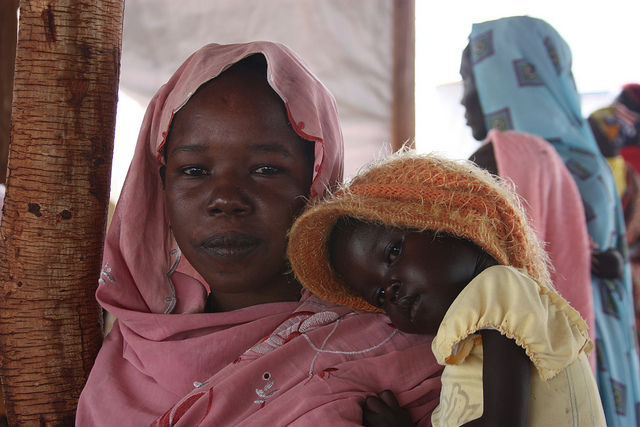Editor’s Note: Over the next three weeks, we will be sharing with you a series of articles on Reproductive Justice, written by Americans United for Life in March of 2010. They have kindly granted us permission to reprint here. In this article, abortion restrictions are discussed.
The term “reproductive justice” took on a personal meaning for me in April of 2008, when I underwent an emergency C-Section. In spite of a flawless pregnancy and topnotch prenatal care, my labor completely stalled, my body simply could not do what it was supposed to do. Fortunately, there was no panic, no fear; in fact, there was never a moment when my husband and I wondered whether we would be able to safely bring our son into the world.
It is difficult to imagine anything more in keeping with reproductive justice , defined by one reproductive rights group as “the complete physical, mental, spiritual, political, economic, and social well-being of women and girls,” than for women to have access to all existing means to safely deliver their children.
We have this form of reproductive justice in the United States. Because of the excellent obstetric care we received, our son was born pink and healthy, I was fine, and I should have no trouble bearing more children.
However, one of my nurses told me that this form of reproductive justice is terribly absent in many parts of the world. She explained that while a C-Section performed in a developing nation only costs US$60.00, millions of women do not have access to the procedure. For a woman without access to quality obstetric care, facing a complicated delivery is devastating — her baby often dies and if she survives, she is left with empty arms and a serious medical condition called an obstetric fistula.
The United Nations defines an obstetric fistula as “a hole in the birth canal caused by prolonged labour without prompt medical intervention, usually a Caesarean section. The woman is left with chronic incontinence and, in most cases, a stillborn baby.”
Fistulas can be repaired for the average cost of about US $300, and the success rate is as high as 90%. However, most women with fistulas do not know that the surgery is available or cannot access or afford it. Therefore, they must live with leaking urine or feces and other chronic medical problems, and are ostracized from society.
The statistics on maternal deaths and injury in developing nations are staggering. Figures released in October 2007 jointly by the UNFPA, WHO, UNICEF and The World Bank show that a woman dies of pregnancy-related causes at the rate of one woman a minute. There are 450 maternal deaths per 100,000 births in developing regions compared to 9 per 100,000 births in developed regions.
Additionally, the United Nations estimates that at least 2 million women in Africa, Asia, and the Arab region are living with fistulas, and approximately 50,000 to 100,000 new cases develop each year.
This problem is not being ignored internationally; however, far too little is being done to address it. The United Nations included improving maternal health as their fifth Millennium Development Goal, aiming to reduce maternal mortality by 75 percent by 2015. However, they will not even come close to that goal at current rates. Further, the UN promotes access to “safe abortion” as a key component in achieving the fifth goal, rather than focusing on improving women’s health and access to quality obstetric care, including pre-natal and post-natal care.
The United Nations is also involved in combating the problem of fistulas, as are private organizations. Perhaps what is most stunning to me, however, is the fact that more “reproductive health resources,” be they private or public, are not being used to improve the deplorable state of maternal healthcare worldwide.
Of the billions of dollars that have been spent on “reproductive health programs,” only a fraction of the funding has been spent on prenatal and obstetric care. As pointed out by MaterCare International, an organization devoted to promoting maternal health care in developing nations, we are all familiar with crimes of commission against women in these countries — sexual assault, genital mutilation, torture — but the extreme neglect that mothers face as a result of insufficient maternal care is just as deadly.
I visited the websites of the most prominent “reproductive rights groups” and found that they were overwhelmingly devoted to overturning “restrictive abortion laws” in developing countries. While they discuss the need for good obstetric care, the vast majority of the articles are focused on pushing a pro-abortion and pro-contraception agenda overseas.
Shouldn’t real reproductive justice fight for the ability for all women to welcome their children into the world? Shouldn’t our focus be on providing basic health care, sanitation, and obstetric care for all women? Why, when cultures in developing nations often welcome large families and value life, are resources diverted from providing care for women and their babies and towards combating abortion laws and pushing contraception? How is that justice?
If I am blessed with another child I will likely need another C-section, and I will get to have it — I don’t even have to think about it. It is heartbreaking that not all moms can have this opportunity, and deplorable that more is not being done to bring reproductive justice to these moms and their babies.
Other posts from AUL’s Reproductive Justice Series:
- Introduction to AUL’s Reproductive Justice Series
- Real Reproductive Justice Encourages Complete Information and Facilitates Life-Affirming Options
- Reproductive Justice for All Moms
- Prenatal Diagnosis and Reproductive Justice
- When Choice Becomes Discrimination
- Real Reproductive Justice Places Women’s Health Above Profit
- Real Reproductive Justice Relies on Medical Reality







